Panasonic AJ-P, AJ-HD1200AP User Manual
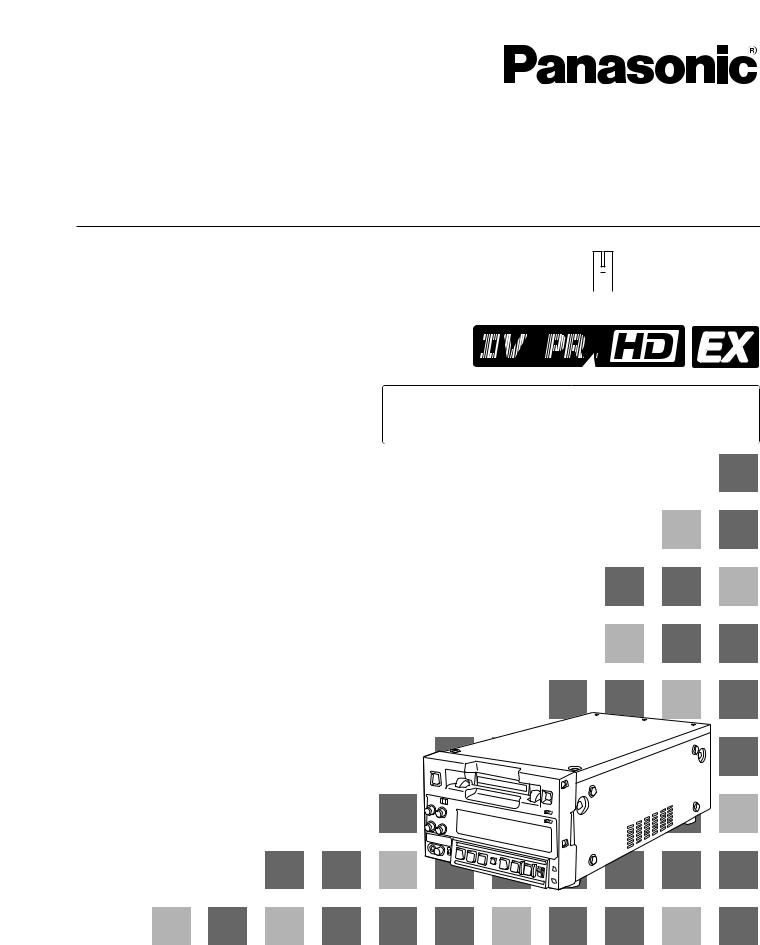
Digital HD Video Cassette Player/Recorder
Operating Instructions
Model No. AJ-


 P
P
The unit’s recording function become operational only when the AJ-YA120AG (optional accessory) or AJ-YAD120AG (optional accessory) has been installed.
Before operating this product, please read the instructions carefully and save this manual for future use.
VQT0L36-1
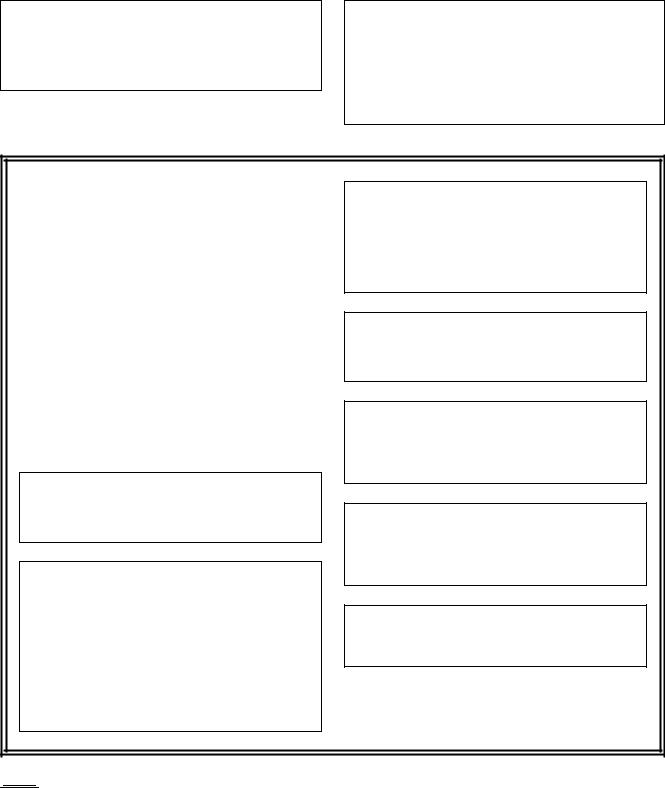
For your safety
IMPORTANT
“Unauthorized recording of copyrighted television programmes, video tapes and other materials may infringe the right of copyright owners and be contrary to copyright laws.”
Operating precaution
Operation near any appliance which generates strong magnetic fields may give rise to noise in the video and audio signals. If this should be the case, deal with the situation by, for instance, moving the source of the magnetic fields away from the unit before operation.
$ THIS APPARATUS MUST BE GROUNDED
To ensure safe operation the three-pin plug must be inserted only into a standard three-pin power outlet which is effectively grounded through normal household wiring. Extension cords used with the equipment must be threecore and be correctly wired to provide connection to the ground. Incorrectly wired extension cords can be extremely hazardous.
The fact that the equipment operates satisfactorily does not imply that it is grounded, and the installation is not necessarily safe. For your safety, if in any doubt about the effective grounding of the equipment or power outlet, please consult a qualified electrician.
$ DO NOT REMOVE PANEL COVER BY
UNSCREWING.
To reduce the risk of electric shock, do not remove cover. No user serviceable parts inside.
Refer servicing to qualified service personnel.
CAUTION:
THE AC OUTLET (MAINS SOCKET) SHALL BE INSTALLED NEAR THE EQUIPMENT AND SHALL BE EASILY ACCESSIBLE.
WARNING:
OTO REDUCE THE RISK OF FIRE OR SHOCK
HAZARD, DO NOT EXPOSE THIS EQUIPMENT TO RAIN OR MOISTURE.
OTO REDUCE THE RISK OF FIRE OR SHOCK
HAZARD, KEEP THIS EQUIPMENT AWAY FROM ALL LIQUIDS-USE AND STORE ONLY IN LOCATIONS WHICH ARE NOT EXPOSED TO THE RISK OF DRIPPING OR SPLASHING LIQUIDS, AND DO NOT PLACE ANY LIQUID CONTAINERS ON TOP OF THE EQUIPMENT.
CAUTION:
Do not install or place this unit in a bookcase, built-in cabinet or any other confined space in order to maintain adequate ventilation. Ensure that curtains and any other materials do not obstruct the ventilation to prevent risk of electric shock or fire hazard due to overheating.
CAUTION:
TO REDUCE THE RISK OF FIRE OR SHOCK HAZARD AND ANNOYING INTERFERENCE, USE THE RECOMMENDED ACCESSORIES ONLY.
CAUTION:
TO REDUCE THE RISK OF FIRE OR SHOCK HAZARD, REFER MOUNTING OF THE OPTIONAL INTERFACE BOARD TO QUALIFIED SERVICE PERSONNEL.
CAUTION:
TO REDUCE THE RISK OF FIRE OR SHOCK HAZARD, REFER CHANGE OF SWITCH SETTING INSIDE THE UNIT TO QUALIFIED SERVICE PERSONNEL.
CAUTION:
Even when the Power Switch is in the OFF position, a small current flows the filter circuit.



 indicates safety information.
indicates safety information.
2
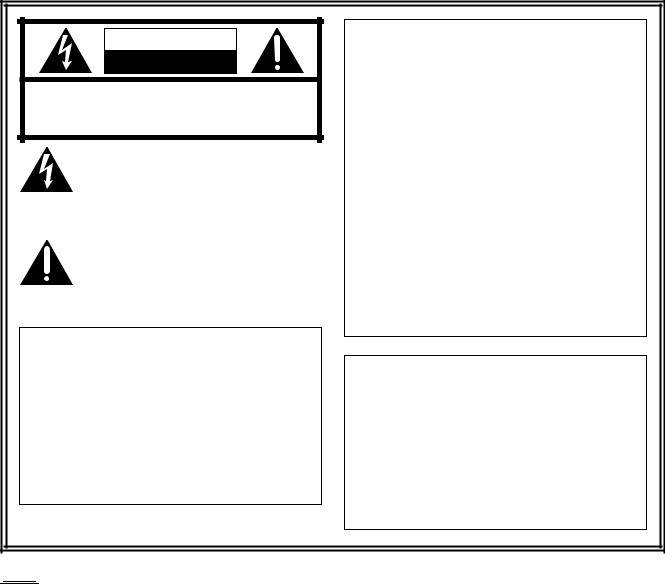
For your safety
CAUTION |
RISK OF ELECTRIC SHOCK |
DO NOT OPEN |
CAUTION: TO REDUCE THE RISK OF ELECTRIC SHOCK, |
DO NOT REMOVE COVER (OR BACK). |
NO USER SERVICEABLE PARTS INSIDE. |
REFER TO SERVICING TO QUALIFIED SERVICE PERSONNEL. |
The lightning flash with arrowhead symbol, within an equilateral triangle, is intended to alert the user to the presence of uninsulated “dangerous voltage” within the product’s enclosure that may be of sufficient magnitude to constitute a risk of electric shock to persons.
The exclamation point within an equilateral triangle is intended to alert the user to the presence of important operating and maintenance (service) instructions in the literature accompanying the appliance.
Notice (U.S.A.only):
This product has a fluorescent lamp that contains a small amount of mercury.
It also contains lead in some components. Disposal of these materials may be regulated in your community due to environmental considerations.
For disposal or recycling information please contact your local authorities, or the Electronics Industries Alliance:
<http://www.eiae.org.>
FCC Note:
This equipment has been tested and found to comply with the limits for a class A digital device, pursuant to Part 15 of the FCC Rules. These limits are designed to provide reasonable protection against harmful interference when the equipment is operated in a commercial environment. This equipment generates, uses, and can radiate radio frequency energy and, if not installed and used in accordance with the instruction manual, may cause harmful interference to radio communications.
Operation of this equipment in a residential area is likely to cause harmful interference in which case the user will be required to correct the interference at his own expense.
Warning:
To assure continued FCC emission limit compliance, the user must use only shielded interface cables when connecting to external units. Also any unauthorized changes or modifications to this equipment could void the user’s authority to operate it.
CAUTION:
This apparatus can be operated at a voltage in the range of 100 – 240 V AC.
Voltage other than 120 V is not intended for U.S.A. and Canada.
CAUTION:
Operation at a voltage other than 120 V AC may require the use of a different AC plug. Please contact either a local or foreign Panasonic authorized service center for assistance in selecting an alternate AC plug.



 indicates safety information.
indicates safety information.
3

Contents
Introduction . . . . . . . . . . . . . . . . . . . . . . . 5 Features . . . . . . . . . . . . . . . . . . . . . . . . . . .5
Parts and their functions . . . . . . . . . . . . . 7
Front panel . . . . . . . . . . . . . . . . . . . . . . . . . . . . . . 7 Rear panel . . . . . . . . . . . . . . . . . . . . . . . . . . . . . . 12
Tapes . . . . . . . . . . . . . . . . . . . . . . . . . . . .14
Inserting the tape . . . . . . . . . . . . . . . . . . . . . . . . .14 Usable tapes . . . . . . . . . . . . . . . . . . . . . . . . . . . .14
Operation . . . . . . . . . . . . . . . . . . . . . . . . .15
Turning on the unit’s power . . . . . . . . . . . . . . . . . 15 STOP mode . . . . . . . . . . . . . . . . . . . . . . . . . . . . 15 Recording . . . . . . . . . . . . . . . . . . . . . . . . . . . . . . 16 Pause/recording (follow-on recording) . . . . . . . . 16 Playback . . . . . . . . . . . . . . . . . . . . . . . . . . . . . . . 17 Cue/review . . . . . . . . . . . . . . . . . . . . . . . . . . . . . 17 Still image playback . . . . . . . . . . . . . . . . . . . . . . 17 Linear 0.3k playback . . . . . . . . . . . . . . . . . . . . . 18 Variable speed playback . . . . . . . . . . . . . . . . . . . 18 Repeat playback . . . . . . . . . . . . . . . . . . . . . . . . . 19
Time code & user’s bit . . . . . . . . . . . . . .20
Time code . . . . . . . . . . . . . . . . . . . . . . . . . . . . . . 20 User’s bit . . . . . . . . . . . . . . . . . . . . . . . . . . . . . . . 20 Setting the time code (from the menu) . . . . . . . . 20 Setting the time code (from the front panel) . . . . 20 Setting the user’s bit . . . . . . . . . . . . . . . . . . . . . . 21 Playing back the time code and user’s bit . . . . . . 21
Superimposed screen displays . . . . . . 22
Setup (initial settings) . . . . . . . . . . . . . . .24
Setting method using the on-screen menus . . . . 24 Returning to the factory settings . . . . . . . . . . . . . 24 Setting the user defaults . . . . . . . . . . . . . . . . . . . 25 Loading the user defaults . . . . . . . . . . . . . . . . . . 26 Menu protection . . . . . . . . . . . . . . . . . . . . . . . . . 26 Releasing the menu protection mode . . . . . . . . . 27 Displaying the DIAG menu . . . . . . . . . . . . . . . . . 27
Setup menus . . . . . . . . . . . . . . . . . . . . . .28
Menus which are displayed . . . . . . . . . . . . . . . . . 28 SYSTEM . . . . . . . . . . . . . . . . . . . . . . . . . . . . . . . 31 BASIC . . . . . . . . . . . . . . . . . . . . . . . . . . . . . . . . . 33 OPERATION . . . . . . . . . . . . . . . . . . . . . . . . . . . . 37 INTERFACE . . . . . . . . . . . . . . . . . . . . . . . . . . . . 40 TAPE PROTECT . . . . . . . . . . . . . . . . . . . . . . . . . 40 TIME CODE . . . . . . . . . . . . . . . . . . . . . . . . . . . . 41 VIDEO . . . . . . . . . . . . . . . . . . . . . . . . . . . . . . . . . 43 AUDIO . . . . . . . . . . . . . . . . . . . . . . . . . . . . . . . . . 46 MENU . . . . . . . . . . . . . . . . . . . . . . . . . . . . . . . . . 48 DIF . . . . . . . . . . . . . . . . . . . . . . . . . . . . . . . . . . . 49
Error messages . . . . . . . . . . . . . . . . . . . .50 Condensation . . . . . . . . . . . . . . . . . . . . .52 Emergency eject . . . . . . . . . . . . . . . . . . . 53 Video head cleaning . . . . . . . . . . . . . . . .53 Maintenance . . . . . . . . . . . . . . . . . . . . . . .53 Specifications . . . . . . . . . . . . . . . . . . . . .54
4
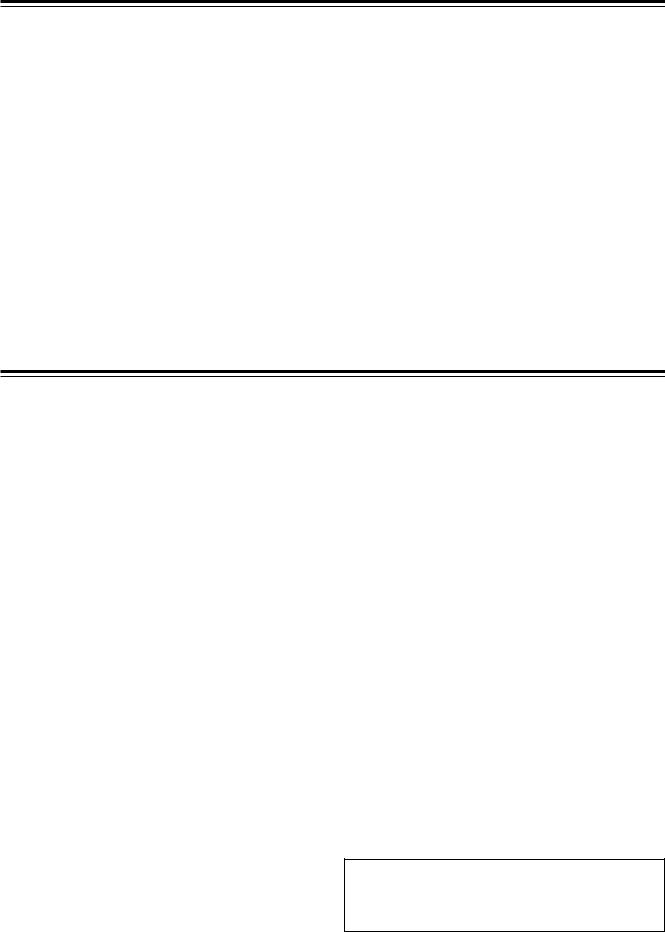
Introduction
The AJ-HD1200A multi-format digital video cassette player is capable of playing not only all types of materials ranging from HD (DVCPRO HD and DVCPRO HD-LP) to SD (DVCPRO50, DVCPRO50P and DVCPRO) recorded in the DVCPRO formats on 1/4-inch wide compact cassette tapes but also consumer DV and DVCAM tapes.
A down-converter provided as a standard feature verifies all tapes, whatever their format, using analog composite output signals.
Furthermore, by installing an optional board, the unit can be used as a recorder to record HD signals (1080i/59.94 Hz, 1080i/50 Hz or 720p/59.94 Hz) in the DVCPRO HD-LP format. In addition, 720/24p over 60p sources recorded using a variable frame rate camera can be converted into 1080/24 PsF format output signals to support cinema applications.
Similarly, 720/25p over 60p sources can be converted into 1080/25 PsF or 576i format output signals. Thanks to the incorporation of highly efficient digital compression technology, the deteriorations in the image and sound quality during dubbing are now significantly reduced with this high image quality VTR. The compact size and light weight of the unit enable it to be carried around and mounted in a standard rack with ease.
You can perform the unit’s settings interactively with the on-screen menus displayed on the TV monitor.
Features
Compact size and light weight.
The unit has a width of 214 mm, a height of 132 mm, and a depth of 428 mm, and weighs only 7.9 kg.
Grips are also attached for easy carry.
Efficient installation in a rack
The unit’s width is one-half of 19 inches and its height is 3U: this translates into greater saving of installation space in a standard rack compared to conventional models.
DVCPRO HD cassette tapes used
The unit uses 1/4-inch wide cassette tapes.
<Note>
When recording2 HD signals, use DVCPRO HD cassettes.
High image quality
The unit achieves a high image quality by recording 4:2:2 HD component signals with a recording rate (=100 Mbps) which is four times as high as that for existing DVCPRO formats.
1080i or 720p, NTSC or PAL selectable
By switching the settings provided for the video signal input (1080i/59.94 Hz or 720p/59.94 Hz) on the setup menu, the unit can record2 and play back the signals of the system selected.
The unit also supports the PAL mode. Playback of 1080i/50 Hz or PAL SD materials is enabled by switching the setting on the system menu.
Frame rate conversion
When playing back a tape recorded at a frame rate of 24 fps using a variable frame rate camera, the tape’s signals can be converted to the 1080/24 PsF format and output by selecting a menu item setting. When playing back a tape recorded at a frame rate of 25 fps, the tape’s signals can be converted to the 1080/25 PsF or 576i format and output.
<Notes>
O Use tapes that are shot with a variable frame rate camera.
O Do not use dubbed or edited tapes. The tape control information may be lost, making it impossible to convert the signals for playback.
O To convert a tape recorded using a frame rate other than 24 (25) fps to the 1080/24 (25) PsF format, use the frame rate converter (AJ-FRC27) available as an optional accessory.
DVCPRO-compatible playback
In addition to DVCPRO HD-LP playback, the unit can play back tapes recorded using the existing DVCPRO HD, DVCPRO50 and DVCPRO formats.
It can also play back consumer DV tapes (SP) and DVCAM tapes.
2 The unit’s recording function become operational only when the AJ-YA120AG (optional accessory) or AJ-YAD120AG (optional accessory) has been installed.
5

Features
SD down-converter
The unit comes with a built-in SD down-converter as a standard feature to enable the output of SD SDI signals2 and analog composite signals at the same time as HD SDI output signals2 and for monitoring the signals on an SD monitor.
Up-converter function2
When an SD format tape is played back, it is possible to up-convert the signals to the HD format while at the same time outputting the signals in the SD format.
Cross-converter function2
The unit comes with a built-in cross-converter to enable 1080i/59 Hz format signals to be converted into 720p/59 Hz format signals or, conversely, to enable 720p/59 Hz format signals to be converted into 1080i/59 Hz format signals.
HD analog component output
This feature enables HD signals to be monitored with ease.
AC/DC operation
The unit supports AC supply voltages ranging from 100V to 240V and DC12V power supply as well.
Follow-on recording function2
Using the REC button and PAUSE button together activates the auto back function, enabling the next image to follow on from the last image with no disruptions in the continuity.
On-screen menu settings
Highly detailed and individualized function settings can be performed on-screen.
Time code
The unit is equipped with a built-in time code generator/time code reader (TCG/TCR). Since time code signals can also be input from an external device2, regeneration to an external time code is possible.
[Multi-functional interfaces]
Serial digital input/output2
The unit’s HD component serial I/O interface enables interfacing with HD component video signals and 8-channel digital audio signals using a single BNC connector. (SMPTE 292M/296M/299M) The unit is also equipped with an SD downconverter as a standard feature so that SD component serial signals can be output as well. (SMPTE 259M-C, 272M-A, ITU-R BT.656-4)
Analog video output
Since the unit’s analog composite down-converter comes as a standard feature, the signals can be monitored on an SD monitor.
9-pin remote
The unit’s 9-pin remote control connector enables it to be operated with an external remote controller (AJ-A95: optional accessory).
IEEE1394 digital input/output
Use of the digital video interface board (AJYAD120AG: optional accessory) enables signals to be input and output using an interface which complies with the IEEE 1394 standard.
<Playback formats and output formats>
Playback format |
|
Output format |
|
|
|
DVCPRO HD-LP, |
|
DVCPRO HD, |
DVCPRO HD |
|
DVCPRO50, DV |
|
|
|
DVCPRO50 |
|
DVCPRO50, DV |
|
|
|
DVCPRO |
|
DVCPRO, DV |
|
|
|
DVCPRO P, DV, DVCAM |
|
DV |
|
|
|
When the E-E mode |
is |
DVCPRO HD, |
established: |
|
DVCPRO50, DV |
O Install the AJ-YA120AG board |
|
|
which is available as an optional |
|
|
accessory. |
|
|
O Select a setting other |
than |
|
“1394” for menu item No.600 |
|
|
[VIDEO IN SEL]. |
|
|
|
|
|
<Notes>
When any of the settings below is established, no signals will be output from the digital video interface.
O When “23/24,” “25(HD)” or “25(SD)” is selected as the menu item No.25 [SYSTEM FREQ] setting
O When “60/24” is selected as the menu item No.030 [HD FREQUENCY] setting
O When “720p” is selected as the menu item No.630 [1080i>HD_OUT] setting
O When “1080i” is selected as the menu item No.632 [720p>HD_OUT] setting
2 The unit’s recording function become operational only when the AJ-YA120AG (optional accessory) or AJ-YAD120AG (optional accessory) has been installed.
6
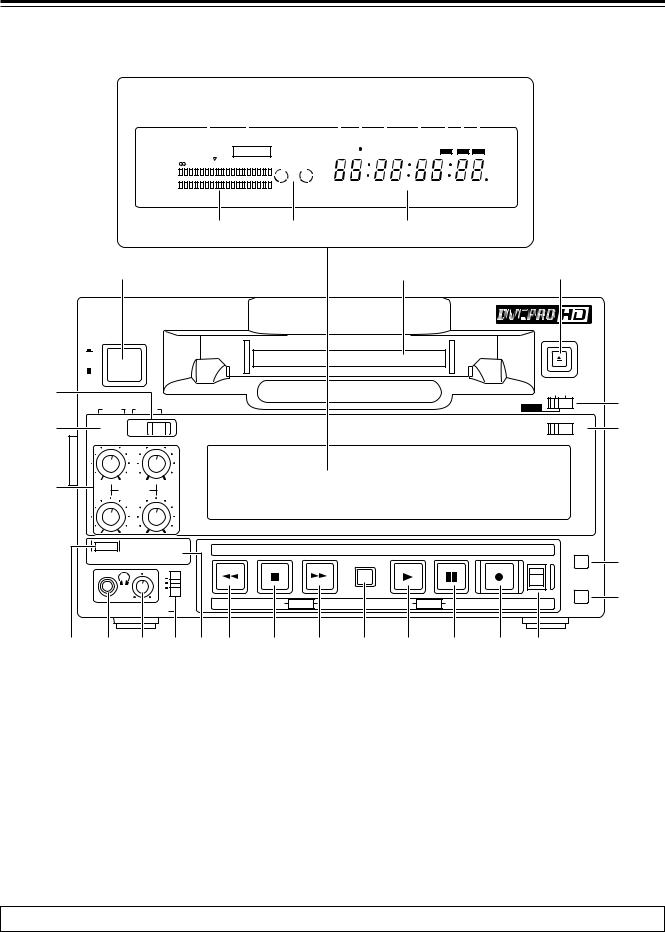
Parts and their functions
Front panel
Counter display
4 |
5 |
6 7 8 |
9 |
: |
|||||||
|
|
|
|
|
|
|
|
|
|
|
|
|
|
|
|
|
|
|
|
|
|
|
|
|
|
|
|
|
|
|
|
|
|
|
|
REC INH REMOTE |
|
|
|
|
|
|
|
DV |
dB - -30 -25 -20 -16 -12 -8 -4 0 |
|
|
|
|
|
|
|
CTL |
CH 1 |
|
|
|
|
|
|
|
TC |
|
|
|
|
|||||
CH 2 |
|
|
|
|
|
|
|
UB |
|
|
|
|
|
|
|
|
;<
< |
SCH SERVO |
HOURS MINUTES SECONDS FRAMES
=
1 |
2 |
3 |
POWER |
EJECT |
ON
OFF
@
?
C
LOCAL REMOTE
AUDIO SELECT
|
INPUT |
METER |
|
|
|
|
|
|
|
MENU |
|
|
ANALOG |
CH3-4 |
|
|
|
|
|
|
|
OFF |
ON |
CH 1 |
|
REC |
CH 2 |
|
|
|
|
|
REC INH (OPTION) |
||
|
|
|
|
|
|
|
|
||||
|
|
|
|
|
|
|
|
|
|
|
|
|
|
PULL |
|
|
|
|
|
|
|
|
|
CH 3 |
FOR VAR |
CH |
4 |
|
|
|
|
|
|
|
|
|
|
|
|
|
|
|
|
|
|||
720 P |
CH1·2 CH3·4 |
REW |
STOP |
FF |
SEARCH |
PLAY PAUSE/STILL |
REC(OPTION) TAPE |
RESET |
|||
|
|
|
|
|
|||||||
|
|
AUDIO OUT SEL |
|
|
|
|
|
|
|
||
|
|
|
|
CH1 |
|
|
|
|
|
|
COUNTER |
|
|
|
|
ST |
|
|
|
|
|
|
|
|
|
|
|
|
|
|
|
|
|
|
|
|
|
|
|
CH2 |
|
|
|
|
|
|
|
|
AUDIO MON SELECT |
PAGE |
DOWN |
MENU UP |
MODE |
s DATA r |
SET |
EE |
|
||
|
|
|
|
|
|
|
|
|
|||
>
Q
P
O
D E F B A G H I J K L M N
1POWER switch
2Cassette slot
Align the center of the cassette with the center of the slot and push it gently inside.
The cassette tape is loaded automatically.
3EJECT button
When this is pressed, the tape is unloaded, and several seconds later the cassette will be automatically ejected.
When it is pressed while the counter display shows the CTL display, the display will be reset.
4REC/REC INH lamp
REC: The lamp lights during recording2.
REC INH:
The lamp lights when the cassette is set to the accidental erasure prevention status.
It also lights when the REC INHIBIT switch Q is set to the ON position. Recording operations cannot be performed while it is lighted.
5REMOTE lamp
This lights when the LOCAL/MENU/REMOTE switch > is set to the REMOTE position.
2 This function is operational only when the AJ-YA120AG (optional accessory) has been installed.
7

Parts and their functions
Front panel
6REPEAT lamp
This lights during repeat playback.
<Note>
The lamp flashes and repeat playback is not performed if the counter display mode which has been set using menu items No.161 [CTL (TC) BGN] and No.162 [END] is at variance from the counter display mode used for repeat playback.
7SYSTEM format lamp
This indicates the status of the mode which has been selected by menu item No.15 [SYSTEM FREQ].
Off: 59/60 Hz mode On: 50 Hz/25 PsF mode
Flashing: 23/24 Hz mode2, 25 Hz mode2
8SCH lamp2
When SD signals are supplied to the HD/SD REF VIDEO IN connector, this lights while the subcarrier phase of the signals is within the prescribed range.
9SERVO lamp
This lights when the drum servo or capstan servo is locked.
:Channel condition lamps
The lamp corresponding with the error rate status lights to indicate the channel condition.
(Green 5 white 5 red)
Green : This lights when the error rates of both the video and audio playback signals are satisfactory.
White : This lights when the error rate of either the video playback signals or audio playback signals has deteriorated. Normal playback images appear even while it is lighted.
Red : This lights when correction or interpolation is initiated for either the video playback signals or audio playback signals.
;Level meter
This indicates the levels of the audio signals.
The levels of the input signals are shown during recording2 or E-E2 selection, and the levels of the output signals are shown during playback.
<Cassette insertion/tape travel indicator lamp
This lights when a cassette is inside the unit.





 : This appears when a tape is inserted and the STANDBY ON mode is established.
: This appears when a tape is inserted and the STANDBY ON mode is established.



 : This appears when a tape is inserted and the STANDBY OFF (HALF LOADING) mode is established.
: This appears when a tape is inserted and the STANDBY OFF (HALF LOADING) mode is established.




 : This appears when the tape is traveling, and the segment display moves as the tape travels.
: This appears when the tape is traveling, and the segment display moves as the tape travels.





 : When the fan has shut down, the “
: When the fan has shut down, the “  ”
” 



 corresponding to the stopped side flashes.
corresponding to the stopped side flashes.
=Counter display
This displays the TC and CTL counts, user’s bit (UB), remaining tape length and total tape length as well as the on-screen information and other messages.
If the voltage drops when the unit is powered with DC power supply, the display flashes to provide a warning.
When the voltage drops down to 10.6 V or so, the unit’s power is automatically turned off. (When “TYPE-A” or “TYPE-B” is not selected as the menu item No.180 [BATTERY SEL] setting)
CTL, TC and UB lamps
The corresponding lamps flash when the TC and UB information cannot be read during playback. The lamps remain lighted when the information can be read properly.
>LOCAL/MENU/REMOTE switch
Use this switch to select the menu settings or control the unit from an external device.
LOCAL:
Select this position when the unit is to be operated using the controls on its operation panel.
MENU:
Select this position to perform on-screen menu settings.
REMOTE:
Select this position when the unit is to be operated using the external remote controller (AJ-A95).
2 This function is operational only when the AJYA120AG (optional accessory) has been installed.
8

Parts and their functions
Front panel
?ANALOG lamp2
This lights when ANALOG is selected for the audio input signals as the menu item No.700 [AUDIO IN SEL] setting. When it is off, the HD SDI signal input or INT SG status is established.
<Note>
The signals which are input for each of the channels when analog signals are supplied are recorded on the following audio tracks of the tape.
CH1 input 5CH1 and CH5 tracks CH2 input 5CH2 and CH6 tracks CH3 input 5CH3 and CH7 tracks CH4 input 5CH4 and CH8 tracks
2 This function is operational only when the AJYA120AG (optional accessory) has been installed.
@METER button and lamp (CH3•4)
Each time the METER button is pressed, the signals which are output to the headphone jack E and represented on the level meter display are switched between CH1/CH2 and CH3/CH4.
When the CH1/CH2 signal levels are displayed, the CH3•4 lamp goes off.
<Note>
The METER button takes effect when LINE is selected as the menu item No.780 [AUD OUT SEL] setting for the analog audio output connectors.
AAudio output lamps (CH1•2, CH3•4)
The audio channels to which the signals are output are indicated by these lamps.
BAudio monitor selector switch
This is used to select the audio monitor output and headphone output channel.
Reference:
Combination of setup menu items and audio outputs selected by the front panel switches
Setup menu item |
|
|
Front panel |
|
|
|
Rear panel |
|
|
|||||||
|
|
|
|
AUDIO OUT connectors |
|
|||||||||||
|
|
|
|
|
|
|
|
|
|
|
|
|
||||
|
|
|
|
|
|
|
|
|
|
|
|
|
|
|
|
|
No.780 |
No.770 |
No.771 |
Audio monitor |
|
Audio |
|
METER |
Headphone |
|
|
|
|
AUDIO |
|||
|
output |
|
|
|
|
|
||||||||||
AUD OUT |
MONITOR |
H.PHONE |
selector switch |
|
|
lamp |
CH1 |
CH2 |
CH3/L |
CH4/R |
||||||
|
lamps |
|
output |
MONITOR |
||||||||||||
SEL |
MIX |
MIX |
B |
|
@ |
|
|
|
|
|
||||||
|
A |
|
|
|
|
|
|
|
||||||||
|
|
|
|
|
|
|
|
|
|
|
|
|
|
|||
|
|
|
|
|
|
|
|
|
|
|
|
|
|
|
|
|
|
|
—— |
CH1 |
|
|
|
|
Off |
L=R (CH1) |
|
|
|
|
L=R (CH1) |
||
|
|
|
|
|
|
|
|
|
|
|
|
|
|
|||
|
|
|
|
|
|
|
|
|
|
|
|
|
|
|||
|
|
|
|
|
|
|
|
CH3•4 |
|
L=R (CH3) |
|
|
|
|
L=R (CH3) |
|
|
|
|
|
|
|
|
|
|
|
|
|
|
|
|
|
|
|
|
STEREO |
|
|
|
|
|
Off |
L=CH1/R=CH2 |
|
|
|
|
L=CH1/R=CH2 |
||
|
|
|
|
|
|
|
|
|
|
|
|
|
|
|
||
|
|
|
|
|
|
|
|
|
|
|
|
|
|
|
||
LINE |
—— |
|
ST |
|
CH1•2 |
|
|
CH3•4 |
|
L=CH3/R=CH4 |
CH1 |
CH2 |
CH3 |
CH4 |
L=CH3/R=CH4 |
|
|
|
|
|
|
|
|
|
|
||||||||
|
|
|
|
|
|
|
|
|
||||||||
|
|
CH1+2 |
|
|
CH3•4 |
|
|
Off |
L=R (CH1+2) |
|
|
|
|
L=R (CH1+2) |
||
|
|
|
|
|
|
|
|
|
|
|
|
|
|
|
||
|
|
|
|
|
|
|
|
|
|
|
|
|
|
|
||
|
|
|
|
|
|
|
|
CH3•4 |
|
L=R (CH3+4) |
|
|
|
|
L=R (CH3+4) |
|
|
|
|
|
|
|
|
|
|
|
|
|
|
|
|
|
|
|
|
—— |
CH2 |
|
|
|
|
Off |
L=R (CH2) |
|
|
|
|
L=R (CH2) |
||
|
|
|
|
|
|
|
|
|
|
|
|
|
|
|||
|
|
|
|
|
|
|
|
|
|
|
|
|
|
|||
|
|
|
|
|
|
|
|
CH3•4 |
|
L=R (CH4) |
|
|
|
|
L=R (CH4) |
|
|
|
|
|
|
|
|
|
|
|
|
|
|
|
|
|
|
|
—— |
—— |
CH1 |
|
|
|
|
|
|
L=R (CH1) |
|
|
L=CH1 |
R=CH1 |
L=R (CH1) |
|
|
|
|
|
|
|
|
|
|
|
|
|
|
|
|
|
|
|
STEREO |
STEREO |
|
|
|
|
|
|
|
L=CH1/R=CH2 |
|
|
L=CH1 |
R=CH2 |
L=CH1/R=CH2 |
|
|
|
|
|
|
|
|
|
|
|
|
|
|
||||
|
CH1+2 |
|
|
|
|
|
|
|
L=R (CH1+2) |
|
|
L=R (CH1+2) |
||||
|
|
|
|
|
|
|
|
|
|
|
|
|
||||
CH1/2 |
|
|
ST |
|
CH3•4 |
|
|
Off |
|
CH1 |
CH2 |
|
|
|
||
CH1+2 |
STEREO |
L=CH1/R=CH2 |
L=CH1+2 |
R=CH1+2 |
L=CH1/R=CH2 |
|||||||||||
|
|
|
|
|
|
|
|
|
|
|||||||
|
|
|
|
|
|
|
|
|
|
|
|
|
||||
|
CH1+2 |
|
|
|
|
|
|
|
L=R (CH1+2) |
|
|
L=R (CH1+2) |
||||
|
|
|
|
|
|
|
|
|
|
|
|
|
||||
|
|
|
|
|
|
|
|
|
|
|
|
|
|
|
|
|
|
—— |
—— |
CH2 |
|
|
|
|
|
|
L=R (CH2) |
|
|
L=CH2 |
R=CH2 |
L=R (CH2) |
|
|
|
|
|
|
|
|
|
|
|
|
|
|
|
|
|
|
|
—— |
—— |
CH1 |
|
|
|
|
|
|
L=R (CH3) |
|
|
L=CH3 |
R=CH3 |
L=R (CH3) |
|
|
|
|
|
|
|
|
|
|
|
|
|
|
|
|
|
|
|
STEREO |
STEREO |
|
|
|
|
|
|
|
L=CH3/R=CH4 |
|
|
L=CH3 |
R=CH4 |
L=CH3/R=CH4 |
|
|
|
|
|
|
|
|
|
|
|
|
|
|
||||
|
CH1+2 |
|
|
|
|
|
|
|
L=R (CH3+4) |
|
|
L=R (CH3+4) |
||||
|
|
|
|
|
|
|
|
|
|
|
||||||
|
|
|
|
|
|
|
|
|
|
|
|
|
||||
CH3/4 |
|
|
ST |
|
CH3•4 |
|
|
CH3•4 |
|
|
CH3 |
CH4 |
|
|
|
|
CH1+2 |
STEREO |
L=CH3/R=CH4 |
L=CH3+4 |
R=CH3+4 |
L=CH3/R=CH4 |
|||||||||||
|
|
|
|
|
|
|
|
|
|
|||||||
|
|
|
|
|
|
|
|
|
|
|
|
|
||||
|
CH1+2 |
|
|
|
|
|
|
|
L=R (CH3+4) |
|
|
L=R (CH3+4) |
||||
|
|
|
|
|
|
|
|
|
|
|
||||||
|
|
|
|
|
|
|
|
|
|
|
|
|
||||
|
|
|
|
|
|
|
|
|
|
|
|
|
|
|
|
|
|
—— |
—— |
CH2 |
|
|
|
|
|
|
L=R (CH4) |
|
|
L=CH4 |
R=CH4 |
L=R (CH4) |
|
|
|
|
|
|
|
|
|
|
|
|
|
|
|
|
|
|
9

Parts and their functions
Front panel
CAnalog audio signal recording level controls2
These are used to adjust the recording levels of the analog audio signals for CH1, CH2, CH3 and CH4 (coupled to CH5, CH6, CH7 and CH8).
These are “pull for variable” controls: pull up a control to adjust it. If a control is pulled down, the signals of the corresponding channel are set to the default level.
<Note>
These controls cannot be used to adjust the levels of HD digital audio signals.
D720p lamp
This lights when the 720p system is selected.
EHeadphone jack
When stereo headphones are connected to this jack, the recording2 or playback sound can be monitored through the headphones.
FVolume control
This is used to adjust the headphones volume.
GREW button
Press this to rewind the tape.
While the button is held down in one of the search modes (search still, FWD search, FWD search still or REV search still), the REV search mode is established, and the tape is reviewed at the speed selected using menu item NO.150 [SEARCH SPEED]. (See page 17)
When the button is pressed in one of the slow modes (slow still, FWD slow or FWD slow still), the tape is played back at the REV linear 0.3k speed. (See page 18)
HSTOP button
When this is pressed, the tape stops traveling, and when the TAPE/EE switch N is set to TAPE, still images can be monitored.
The cylinder continues to rotate even in the stop mode, and the tape remains tightly wound around it.
When the unit has been in the stop mode for a period exceeding the prescribed time, it is automatically set to the standby OFF (half loading) mode in order to protect the tape.
The stop mode is established immediately after a tape is inserted into the unit.
When a still image is displayed, noise may appear on the monitor: this is normal and not indicative of trouble.
IFF button
Press this to fast forward the tape.
While the button is held down in one of the search modes (search still, REV search, REV search still or FWD search still), the FWD search mode is established, and the tape is cued at the speed selected using menu item NO.150 [SEARCH SPEED]. (See page 17)
When the button is pressed in one of the slow modes (slow still, REV slow or REV slow still), the tape is played back at the FWD linear 0.3k speed. (See page 18)
JSEARCH button
When this is pressed, the unit is set to the search mode or slow mode. (See pages 17, 18)
KPLAY button
Press this to start playback.
Recording starts when it is pressed together with the REC button.
LPAUSE/STILL button
When this is pressed during recording, the tape temporarily stops (pauses). When it is pressed again, recording2 is resumed.
When it is pressed during playback, a still image appears. When it is pressed again, playback is resumed.
When it is pressed during FWD or REV search, the tape pauses (FWD or REV search still). When it is pressed again, the FWD or REV search is resumed.
When it is pressed during FWD or REV slow playback, the tape pauses (FWD or REV slow still). When it is pressed again, the FWD or REV slow playback is resumed.
In the FWD or REV slow playback mode, the tape is played back at the linear 0.3k speed.
When the tape pauses, noise may appear on the monitor: this is normal and not indicative of trouble. (See page 18)
2 This function is operational only when the AJYA120AG (optional accessory) or AJ-YAD120AG (optional accessory) has been installed.
10

Parts and their functions
Front panel
MREC button2
No optional board installed
This unit is a video cassette player so it cannot record by pressing the REC button.
When the REC button is pressed, the REC INH lamp on the counter display lights for several seconds. When T&S&M has been selected as the menu item No.006 [DISPLAY SEL] setting, “NO OPTION FOR REC” appears in the superimposed mode display area.
When the AJ-YA120AG or AJ-YAD120AG is installed
When the REC button is pressed together with the PLAY button, recording starts. When it is pressed during stop or eject, the input video signals and audio signals can be checked even when the TAPE/EE switch is set to TAPE.
The value of the time code generator can also be checked. (REC CHECK mode)
The REC CHECK mode is released when the STOP button or other operation button is pressed.
NTAPE/EE switch
This is used to select the signals which are to be output in the STOP mode.
TAPE:
The signals played back from the tape are output.
EE:
No optional board installed
The signals selected by menu item No.106 [EJECT EE SEL] are output. The black signal for the video signals and mute for the audio output are the factory settings.
When the AJ-YA120AG or AJ-YAD120AG is installed
The signals selected by menu item No.600 [VIDEO IN SEL] are output as the video signals, and the signals selected by menu item No.700 [AUDIO IN SEL] are output as the audio signals.
However, when “1394” is selected as the VIDEO IN SEL setting, the audio input signals will also be supplied from the DV connector (digital video interface).
<Note>
The image and sound may be disrupted when this switch’s position is changed.
OCOUNTER button
This is used to switch the counter display.
Each time it is pressed, the display is switched by one step in the following sequence: CTL 5 TC 5 UB 5 r 5 PB FORMAT 5 CTL and so on.
CTL : The tape timer (control signal) is displayed.
TC |
: |
The time code is displayed. |
UB |
: |
The user’s bit is displayed. |
r: The remaining tape length and total tape length are displayed in 1-minute increments.
Example:
r30-46 = 30 minutes of tape remaining out of a total tape length of 46 minutes
PB FORMAT:
The format of the tape now playing is displayed.
Playback tape format |
Counter display |
|
|
DVCPRO HD-LP (1080i) |
Hd 1080 |
|
|
DVCPRO HD-LP (720P) |
Hd 720P |
DVCPRO HD (1080i) |
Hd 1080 SP |
DVCPRO HD (720P) |
Hd 720P SP |
DVCPRO50 (422) |
Sd 50 |
DVCPRO (411) |
Sd 25 |
DVCPRO50 (420P) |
Sd 50P |
DV |
The DV lamp on the counter |
|
display lights. |
DVCAM |
–––— |
PRESET button
When this is pressed in the CTL mode, the counter display is reset to zero.
QREC INHIBIT switch2
This is used to enable or disable recording on the cassette tape.
ON : Recording on the cassette tape is disabled. The REC INHIBIT lamp on the display lights.
OFF : When the cassette tape’s accidental erasure prevention mechanism is at the recording enable setting, recording onto the cassette tape is enabled.
2 This function is operational only when the AJYA120AG (optional accessory) or AJ-YAD120AG (optional accessory) has been installed.
11
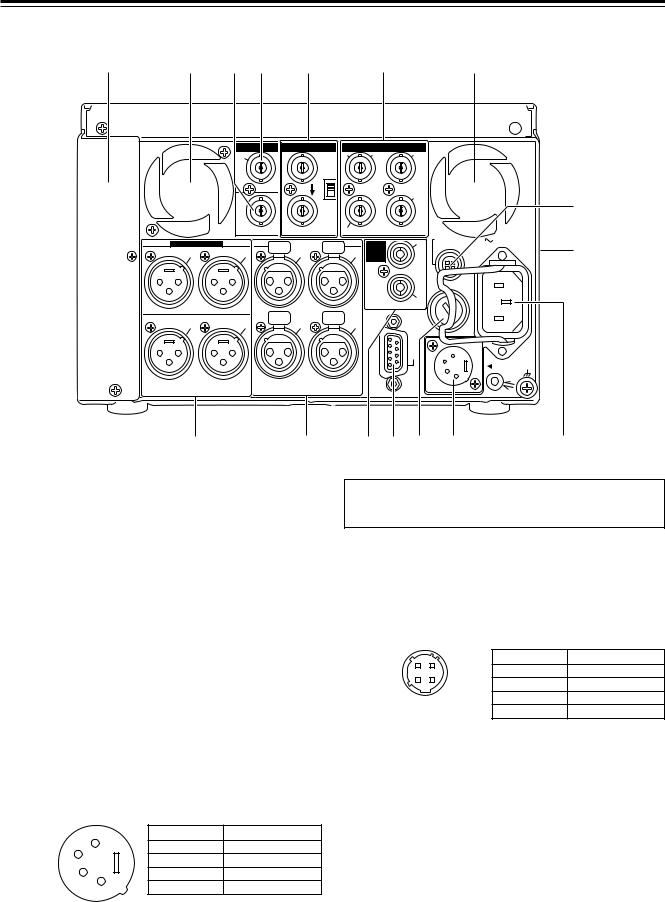
Parts and their functions
Rear panel
? |
= 7 6 8 |
5 |
= |
|
TC |
HD/SD REF VIDEO IN |
|
VIDEO OUT |
|
|
|
||
|
IN |
|
|
(OPTION) |
1 |
Y/G |
PB/B |
|
|
|
|
|
|
75Ω |
|
|
|
|
|
|
|
|
|
ON |
|
|
|
|
|
|
(OPTION) |
|
|
|
|
|
|
|
|
|
|
|
|
OFF |
|
|
PR/R |
|
|
|
|
|
|
|
|
|
|
|
|
|
OUT |
|
|
|
2(SUPER) |
|
|
|
|
|
|
|
|
|
|
|
AC IN |
||
AUDIO OUT |
|
PUSH |
IN |
PUSH |
|
AUDIO |
L |
DC OUT |
|
CH 1 |
CH 2 |
CH 1 |
CH 2 |
MON |
|
12V 250mA |
|
||
|
|
|
|
|
|||||
|
|
|
|
|
|
OUT |
|
|
|
|
|
|
|
|
|
|
|
FUSE |
|
|
|
|
|
|
|
|
R |
F1 |
|
|
|
|
|
|
|
|
|
|
|
CH 3 |
CH 4 |
PUSH |
CH 3 |
PUSH |
CH 4 |
|
R |
|
|
|
|
|
E |
|
|
||||
|
|
|
|
|
|
|
M |
|
|
|
|
|
|
|
|
|
O |
|
|
|
|
|
|
|
|
|
T |
|
|
|
|
|
|
|
|
|
E |
|
SIGNAL |
|
|
|
|
|
|
|
|
|
DC IN GND |
L  R
R
MONITOR
: |
9 ; < 4 2 |
3
>
1
1AC IN inlet
This is the AC power inlet.
Connect the accessory power cable here.
When both an AC power supply and DC power supply have been connected, the AC power supply takes priority.
2DC IN socket
This is the input connector for the DC 12V supply voltage.
Use the optional AC adapter (AJ-B75 or AJ-B95). When the voltage has dropped to around 10.6V, the unit’s power is automatically turned off. (When “TYPE-A” or “TYPE-B” is not selected as the menu item No.180 [BATTERY SEL] setting)
Even when the supply voltage is restored later, the power will not automatically come back on. The POWER switch must be set to OFF and then back to ON several seconds later.
When both AC power supply and DC power supply are connected, the AC power supply takes priority.
|
|
Pin No. |
Signal |
1 |
|
1 |
Ground |
2 |
|
2 |
––– |
|
|
||
3 |
4 |
3 |
––– |
|
4 |
+12 V |
|
|
|
<Note>
Supplying +12V power to the GND terminal by mistake may give rise to ignition, resulting in a fire, or it may cause injury.
3DC OUT socket
This is the DC 12V output socket.
Power is supplied from here to the external remote controller (AJ-A95).
The DC power cable is packed together with the AJ-A95.
2 |
3 |
Pin No. |
Signal |
1 |
Ground |
||
1 |
4 |
2 |
––– |
|
|
||
|
|
3 |
––– |
|
|
4 |
+12 V |
4Fuse holder
This holds the AC 250 V/2.5 A fuse (time lag type).
<Note>
Use the fuse specified by Panasonic.
12
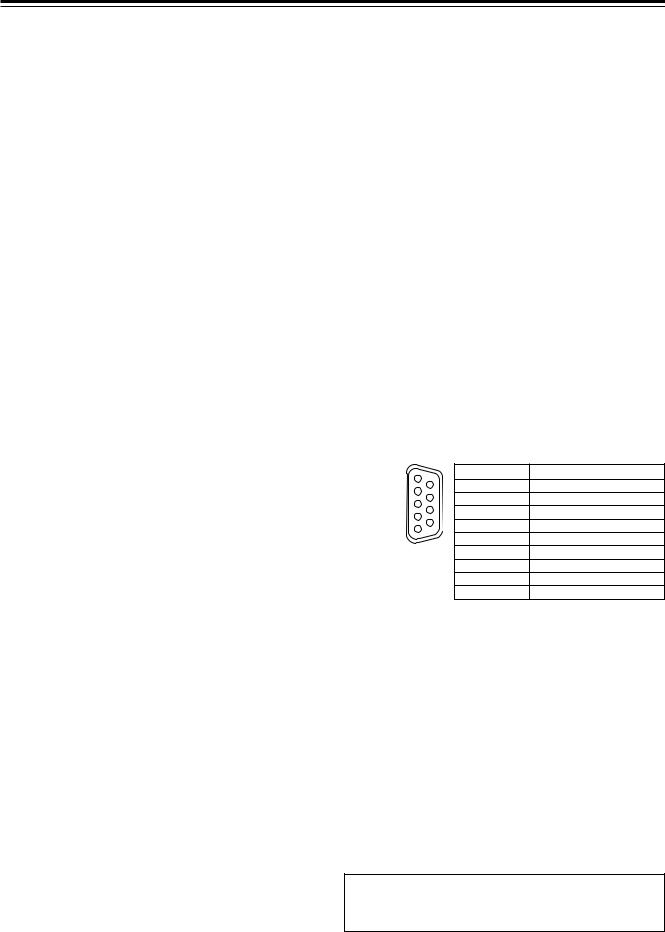
Parts and their functions
Rear panel
5VIDEO OUT (1, 2, Y/G, PB/B, PR/R) connectors
By changing the menu item No.615 [V OUT SEL] setting, either analog composite video signals or HD analog component Y (or G) signals are output from the VIDEO OUT1 connector.
By selecting the menu item No.616 [OUT MATRIX] setting, Y/PB/PR or R/G/B signals can be selected as the HD analog component signals.
Video signals with superimposed information embedded can be output from the VIDEO OUT2 connector.
Whether superimposed information is to be embedded in the signals is selected using menu item No.005 [SUPER].
<Notes>
O When HD analog component output or HD SDI output2 signals are output with the 60 Hz or 24 Hz system frequency, the SD SDI2 signals will be output without the sync signals (NO SYNC), and the analog composite signals will be output in the black-and-white mode (burst OFF).
O A dummy sync signal for preventing the monitor from operating incorrectly is added to the sync signals in the RGB output.
6TC IN connector2
This is used to record an external time code onto the tape.
7TC OUT connector
This is used to output the playback time code during playback.
During recording2, the time code generated by the internal time code generator is output from this connector.
8HD/SD REF VIDEO IN connectors and 75Ω termination switch2
These are the input connectors for the HD/SD reference video signal. For termination, set the switch to ON.
<Notes>
O When inputting an HD reference signal to the connector, input a tri-level sync signal with positive and negative polarities. Also, supply signals matching the input signals and tape format.
O When inputting an SD reference signal to the connector, use composite video signals which satisfy the RS-170A standard or a black burst signal.
9AUDIO IN connectors (CH1, CH2, CH3, CH4)2
These are the input connectors for the analog audio signals.
:AUDIO OUT/MONITOR connector (CH1, CH2, CH3, CH4)
These are the output connectors for the analog audio signals.
The CH3 and CH4 connectors are also used as the audio monitor output connectors (left and right channels). (See page 9)
;AUDIO MONITOR connectors
These are the audio monitor output connectors. The same signals are output as the headphone output signals.
<Note>
The output signal level is fixed.
<REMOTE CONTROL connector
An external remote controller (AJ-95: optional accessory) is connected here to enable the unit to be operated using an external device.
<Notes>
O Set the LOCAL/MENU/REMOTE switch to REMOTE.
O The connector satisfies the RS-422A interface standard, but no editing-related functions are operational.
1 |
6 |
Pin No. |
Signal |
|
1 |
Frame Ground |
|
|
|
||
|
|
2 |
Transmit A |
|
|
3 |
Receive B |
5 |
9 |
4 |
Receive Common |
|
5 |
––—– |
|
|
|
||
|
|
6 |
Transmit Common |
|
|
7 |
Transmit B |
|
|
8 |
Receive A |
|
|
9 |
Frame Ground |
=Fan motor
This is provided to cool off the unit.
>Grips
Grips are provided on both sides of the unit, but the unit should be placed on a flat, level surface for operation.
?Option panel
When the AJ-YA120AG or AJ-YAD120AG option is to be installed, remove this panel, and replace it with the panel packed with the option.
For details on installation, refer to the instructions accompanying the option concerned.
2 This function is operational only when the AJYA120AG (optional accessory) has been installed.
13
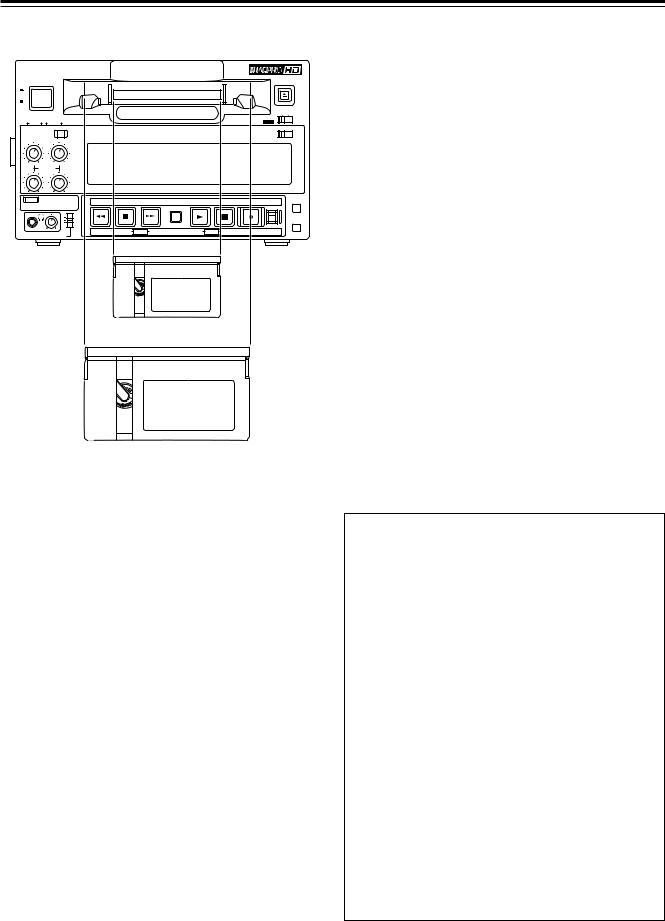
Tapes
Inserting the tape
|
POWER |
|
|
|
|
|
|
|
|
EJECT |
||
ON |
|
|
|
|
|
|
|
|
|
|
|
|
OFF |
|
|
|
|
|
|
|
|
|
|
|
|
AUDIO SELECT |
|
|
|
|
|
|
|
LOCAL REMOTE |
||||
|
|
|
|
|
|
|
MENU |
|
|
|||
|
INPUT |
METER |
|
|
|
|
|
|
|
|
|
|
|
ANALOG |
CH3-4 |
|
|
|
|
|
|
|
OFF |
|
ON |
CH 1 |
|
REC |
CH 2 |
|
|
|
|
|
REC INH (OPTION) |
|||
|
|
|
|
|
|
|
|
|
||||
|
|
|
|
|
|
|
|
|
|
|
|
|
|
|
PULL |
|
|
|
|
|
|
|
|
|
|
CH 3 |
FOR VAR |
CH |
4 |
|
|
|
|
|
|
|
|
|
|
|
|
|
|
|
|
|
|
|
|||
720 P |
CH1·2 CH3·4 |
REW |
STOP |
FF |
SEARCH |
PLAY PAUSE/STILL |
REC(OPTION) TAPE |
RESET |
||||
|
|
|
|
|
||||||||
|
|
AUDIO OUT SEL |
|
|
|
|
|
|
|
|
||
|
|
|
|
CH1 |
|
|
|
|
|
|
|
COUNTER |
|
|
|
|
ST |
|
|
|
|
|
|
|
|
|
|
|
|
CH2 |
|
|
|
|
|
|
|
|
|
AUDIO MON SELECT |
PAGE |
DOWN MENU |
UP |
MODE |
s DATA r |
SET |
EE |
|
|
||
|
|
|
|
|
|
|
|
|
|
|||
Align the cassette with the center of the slot and push it gently inside.
The cassette tape is loaded automatically.
M cassette size
L cassette size
Usable tapes
Consumer DV, DVCAM cassettes
Standard DV, DVCAM cassettes Mini DV, DVCAM cassettes
Note that long-playing mini DV cassette tapes (80 minutes in standard mode, 120 minutes in long-playing mode) cannot be used.
For consumer DV tapes, Panasonic recommends the Panasonic brand.
Mcassettes
DVCPRO HD-LP
Tapes with up to 33 minutes of recording/playback (AJ-HP33EMG)
DVCPRO 25/50/50P HD playback tapes
Lcassettes
DVCPRO HD-LP
Tapes with up to 92 minutes of recording/playback (AJ-HP64ELG, AJHP92ELG)
DVCPRO 25/50/50P HD playback tapes
Precautions for using consumer DV and DVCAM cassettes
O Use a cassette adapter (AJ-CS455P) when using mini DV or DVCAM cassette tapes.
Inserting a mini DV or DVCAM cassette tape into the unit without using a cassette adapter may cause trouble or malfunctioning.
O Tapes recorded in the LP modes cannot be played back.
O When editing material recorded on a consumer DV or DVCAM cassette tape, record the material onto a DVCPRO tape or onto another broadcast VTR before use.
O The maximum transport speed of a mini DV or DVCAM cassette tape is 32x normal tape speed.
O The images may be disrupted when a consumer DV or DVCAM cassette tape is played back in a slow motion mode.
O To protect your tapes, refrain as much as possible from repeatedly cueing up the tapes in consumer DV or DVCAM cassettes at the same place.
O When consumer DV or DVCAM cassette tapes are used, the maximum STILL TIMER time is set to 10 seconds.
14
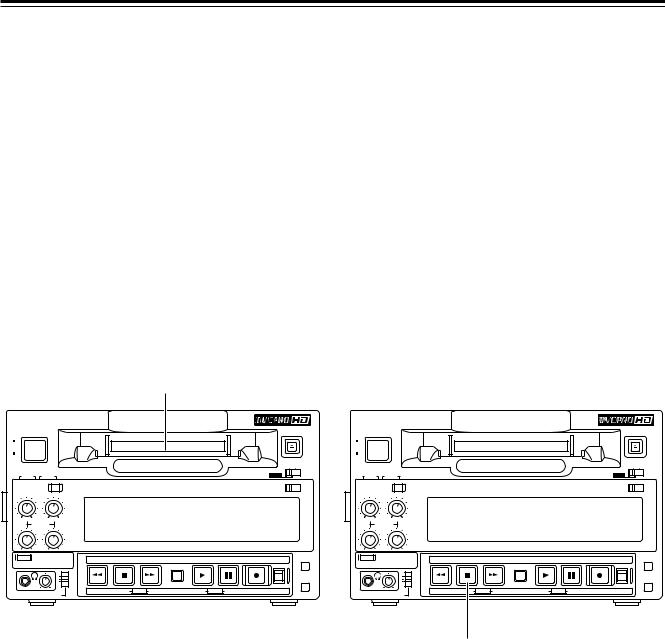
Operation
Turning on the unit’s power |
STOP mode |
<Precaution for STILL TIMER setting>
O If the same locations on the same tape are repeatedly used, the cumulative standby time at these same locations will continue to mount up. To protect your tapes, minimize the amount of standby time at the same locations on the tapes.
|
POWER |
|
|
|
|
|
|
|
|
EJECT |
|
POWER |
|
|
|
|
|
|
|
|
EJECT |
||||
ON |
|
|
|
|
|
|
|
|
|
|
|
|
ON |
|
|
|
|
|
|
|
|
|
|
|
|
OFF |
|
|
|
|
|
|
|
|
|
|
|
|
OFF |
|
|
|
|
|
|
|
|
|
|
|
|
AUDIO SELECT |
|
|
|
|
|
|
|
LOCAL REMOTE |
AUDIO SELECT |
|
|
|
|
|
|
|
LOCAL REMOTE |
||||||||
|
|
|
|
|
|
|
MENU |
|
|
|
|
|
|
|
|
|
MENU |
|
|
||||||
|
INPUT |
METER |
|
|
|
|
|
|
|
|
|
|
INPUT |
METER |
|
|
|
|
|
|
|
|
|
||
|
ANALOG |
CH3-4 |
|
|
|
|
|
|
|
OFF |
|
ON |
|
ANALOG |
CH3-4 |
|
|
|
|
|
|
|
OFF |
|
ON |
CH 1 |
|
REC |
CH 2 |
|
|
|
|
|
REC INH (OPTION) |
CH 1 |
|
REC |
CH 2 |
|
|
|
|
|
REC INH (OPTION) |
||||||
|
|
|
|
|
|
|
|
|
|
|
|
|
|
|
|
|
|
||||||||
|
|
|
|
|
|
|
|
|
|
|
|
|
|
|
|
|
|
|
|
|
|
|
|
||
|
|
PULL |
|
|
|
|
|
|
|
|
|
|
|
|
PULL |
|
|
|
|
|
|
|
|
|
|
CH 3 |
FOR VAR |
CH |
4 |
|
|
|
|
|
|
|
|
CH 3 |
FOR VAR |
CH |
4 |
|
|
|
|
|
|
|
|
||
|
|
|
|
|
|
|
|
|
|
|
|
|
|
|
|
|
|
|
|
||||||
720 P |
CH1·2 CH3·4 |
REW |
STOP |
FF |
SEARCH |
PLAY PAUSE/STILL REC(OPTION) TAPE |
RESET |
720 P |
CH1·2 CH3·4 |
REW |
STOP |
FF |
SEARCH |
PLAY PAUSE/STILL REC(OPTION) TAPE |
RESET |
||||||||||
|
|
|
|
|
|
|
|
|
|
||||||||||||||||
|
|
AUDIO OUT SEL |
|
|
|
|
|
|
|
|
|
|
AUDIO OUT SEL |
|
|
|
|
|
|
|
|
||||
|
|
|
|
CH1 |
|
|
|
|
|
|
|
COUNTER |
|
|
|
|
CH1 |
|
|
|
|
|
|
|
COUNTER |
|
|
|
|
ST |
|
|
|
|
|
|
|
|
|
|
|
ST |
|
|
|
|
|
|
|
||
|
|
|
|
CH2 |
|
|
|
|
|
|
|
|
|
|
|
|
CH2 |
|
|
|
|
|
|
|
|
|
AUDIO MON SELECT |
PAGE |
DOWN MENU |
UP |
MODE |
s DATA r |
SET |
EE |
|
|
|
AUDIO MON SELECT |
PAGE |
DOWN |
MENU UP |
MODE |
s DATA r |
SET |
EE |
|
|
||||
|
|
|
|
|
|
|
|
|
|
|
|
|
|
|
|
|
|
|
|
||||||
1
15

Operation
Recording
This function can be used only when the AJ-YA120AG (optional accessory) has been installed.
1 Set the cassette tape’s erasure prevention tab to recording enable, and insert the tape.
2 Press the STOP button to set the unit to the STOP mode.
3 Selecting the input video signals
Use menu item No.600 [VIDEO IN SEL] to select the video input signals.
4 1. Selecting the input audio signals
1)Connect the signals to be recorded.
2)Use menu item No.700 [AUDIO IN SEL] to select the audio input signals.
<Note>
When “1394” is selected as the menu item No.600 [VIDEO IN SEL] setting, the audio signals are input from the DV connector (digital video interface) regardless of the AUDIO IN SEL setting.
2.Adjusting the analog audio levels
O Adjust the levels of the audio input signals when analog audio signals have been selected as the audio input signals.
When the audio recording level controls are at their pushed-in positions, the audio signals are recorded at the proper levels.
<Note>
When HD SDI signals or signals from the DV connector (digital video interface) are selected as the audio input signals, it is not possible to adjust their level.
5 While holding down the REC button, press the PLAY button.
The REC and PLAY lamps light, and recording commences.
When ALL has been selected as the menu item No.154 [AUTO BACK] setting, the tape is rewound for several seconds from the position where the REC and PLAY buttons were pressed. The tape will run up, and recording will start from the position where the REC and PLAY buttons were pressed so that the new recording will follow on from the previous recording with no disruptions in the continuity of the images.
6 To end the recording, press the STOP button.
Recording now ends, and the unit is set to the stop mode.
<Note>
Check that the SERVO lamp remains lighted during recording. When it flashes or it is off, the playback images will be disrupted.
Pause/recording (follow-on recording)
1 Press the PAUSE/STILL button while the cassette tape is playing back.
2 Press the REC button to set the unit to the REC PAUSE mode.
The monitor display now switches to the E-E screen.
When REC-P or ALL has been selected as the menu item No.154 [AUTO BACK] setting, the tape will be rewound for several seconds from the position where the PAUSE/STILL button was pressed.
3 Press the PAUSE/STILL button to start recording.
The tape now runs as far as the position where the PAUSE/STILL button was pressed in step 1, and recording commences.
<Note>
The E-E screen is now displayed.
4 Press the PAUSE/STILL button again to temporarily stop the recording.
When REC-P or ALL has been selected as the menu item No.154 [AUTO BACK] setting, the tape will be rewound for several seconds from the position where the PAUSE/STILL button was pressed, and then it will stop temporarily.
5 Follow-on recording can be performed by repeating steps 3 and 4.
16

Operation
Playback
1 Insert a cassette tape into the unit.
2 Press the PLAY button.
Normal playback now commences.
3 To end playback, press the STOP button.
The VTR is set to the stop mode.
<Notes>
O Check that the SERVO lamp remains lighted during recording. When it flashes or it is off, the playback images will be disrupted.
O When playback starts up, the images will be disrupted for a moment.
Cue/review
When the FF or REW button is pressed while one of the search modes (search still, FWD search, REV search, FWD search still or REV search still) is established, the tape is cued or reviewed at the speed which was set using menu item No.150 [SEARCH SPEED].
Furthermore, when the FF is pressed during cue or the REW button is pressed during review, the cue or review speed can be increased to 1.85x normal tape speed. When the FF or REW button is pressed again, the tape is restored to the speed which was set using menu item No.150 [SEARCH SPEED].
When the SEARCH button is pressed in the FF mode or REW mode, the tape first slows down to the speed which was set using menu item No.150 [SEARCH SPEED], and cue or review is then performed.
When the PAUSE/STILL button is pressed during cue or review, the tape is temporarily stopped (paused). When it is pressed again, cue or review is resumed.
VTR operation |
Button operated |
Resulting VTR |
|
status |
operation |
||
|
|||
|
|
|
|
|
SEARCH |
Search still |
|
PLAY or STOP |
|
|
|
FF or REW |
FF or REW |
||
|
|||
|
|
|
|
|
PLAY or STOP |
PLAY or STOP |
|
FF |
|
|
|
SEARCH |
FWD search (cue) |
||
|
|||
|
|
|
|
|
PLAY or STOP |
PLAY or STOP |
|
REW |
|
|
|
SEARCH |
REV search (review) |
||
|
|||
|
|
|
|
|
PLAY or STOP |
PLAY or STOP |
|
|
|
|
|
Search still |
FF |
FWD search (cue) |
|
|
|
|
|
|
REW |
REV search (review) |
|
|
|
|
|
|
SEARCH |
FF |
|
|
|
|
|
|
FF |
FWD search speed |
|
|
switching |
||
FWD search (cue) |
|
||
|
|
||
REW |
REV search (review) |
||
|
|||
|
|
|
|
|
PAUSE/STILL |
FWD search still |
|
|
|
|
|
|
SEARCH |
REW |
|
|
|
|
|
REV search |
FF |
FWD search (cue) |
|
|
|
||
(review) |
REW |
REV search speed |
|
|
switching |
||
|
|
||
|
|
|
|
|
PAUSE/STILL |
REV search still |
|
|
|
|
|
|
PAUSE/STILL or |
FWD search (cue) |
|
|
SEARCH or REW |
||
FWD search still |
|
||
|
|
||
|
REW |
REV search (review) |
|
|
|
|
|
|
PAUSE/STILL or |
REV search (review) |
|
|
SEARCH or REW |
||
REV search still |
|
||
|
|
||
|
FF |
FWD search (cue) |
|
|
|
|
|
|
PLAY |
PLAY |
|
Any status |
|
|
|
STOP |
STOP |
||
|
|||
|
|
|
Still image playback
Press the PAUSE/STILL button during playback. When it is pressed again, normal playback is restored.
<Notes>
O No sound is heard during still image playback. O Noise may appear on the still images.
17
